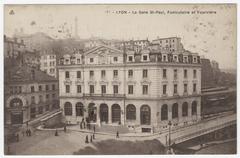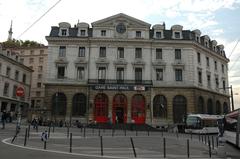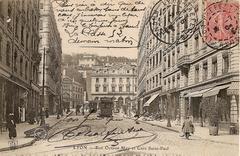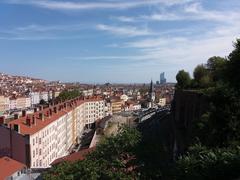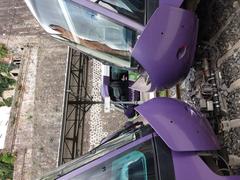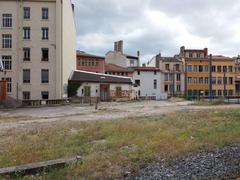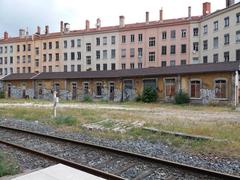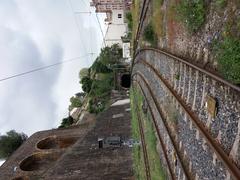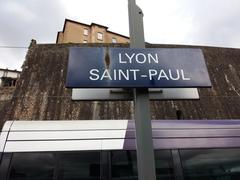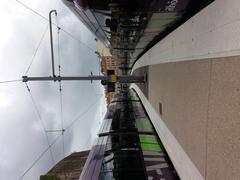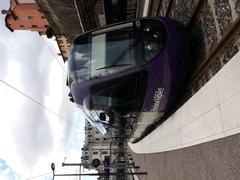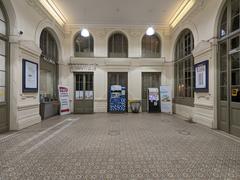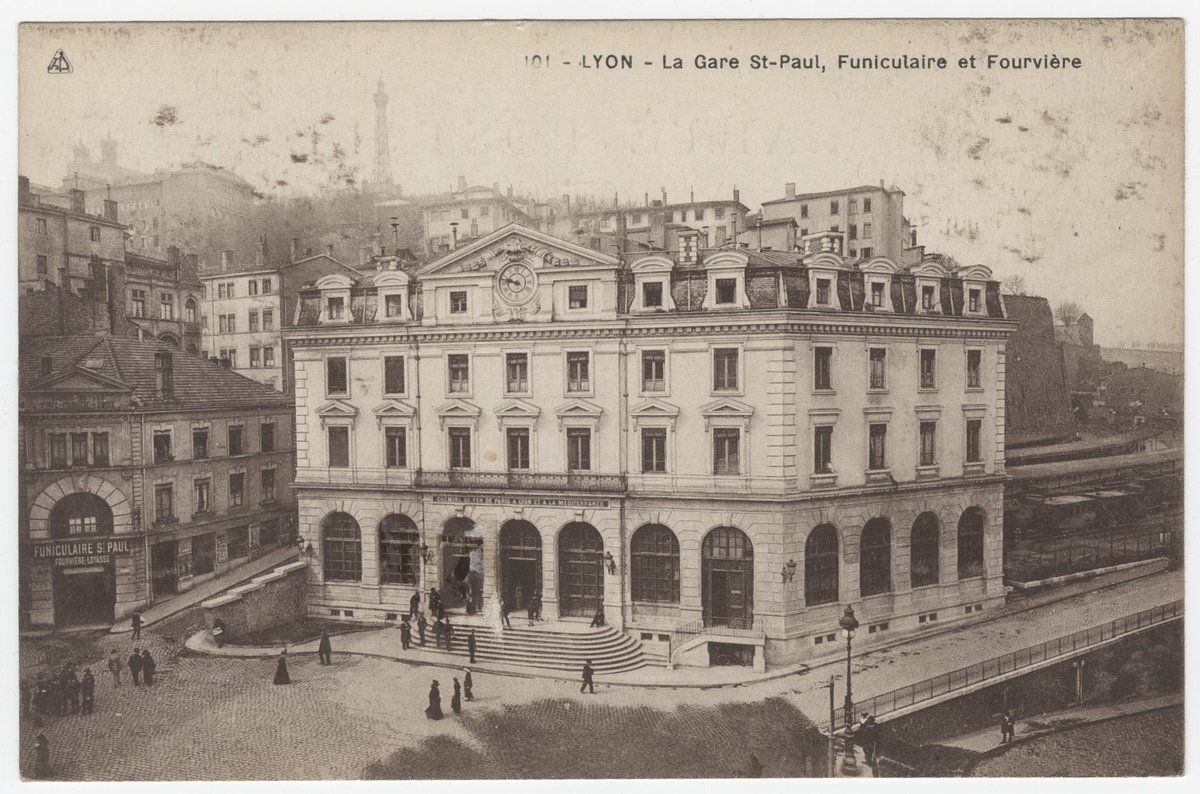
Lyon-Saint-Paul Station: Visiting Hours, Tickets, and Complete Tourist Guide to Lyon’s Historic Heart
Date: 15/06/2025
Introduction: Lyon-Saint-Paul Station – Historic Gateway to Vieux Lyon
Lyon-Saint-Paul Station stands as a remarkable testament to the city’s evolution, blending 19th-century industrial ambition with the Renaissance charm of Vieux Lyon. Located in the 5th arrondissement, at the northern edge of the UNESCO-listed Old Town, the station is not just a transport hub—it’s a vibrant piece of Lyon’s living heritage. Inaugurated in 1876 to expand rail access to the western suburbs, Lyon-Saint-Paul catalyzed the revival of a once-neglected district, shaping both the urban landscape and the city’s social fabric (Wikipedia - Gare de Lyon-Saint-Paul; visitonslyon.com).
Architecturally, Lyon-Saint-Paul exemplifies 19th-century ingenuity, sporting a distinctive wood-metal framework and a U-shaped layout that harmonizes with nearby Renaissance buildings. Its classical façade, Haussmannian influences, and integration of railway worker housing all reflect the era’s priorities—innovation, functionality, and urban renewal (Exposition-Lyon). Today, the station connects regional TER trains, tram-trains, buses, and river shuttles, serving as a true gateway to both the storied streets of Vieux Lyon and the broader metropolitan area (traveltolyon.com).
This guide provides everything you need to know: history, architecture, visiting hours, ticketing, accessibility, connections, and tips for making the most of Lyon-Saint-Paul Station as you explore one of France’s most captivating urban environments.
Table of Contents
- Origins and Construction of Lyon-Saint-Paul Station
- Architectural Features and Heritage
- Urban Impact and District Transformation
- Evolution of Services and Modernization
- Transport Connectivity and Visitor Experience
- Visiting Lyon-Saint-Paul Station: Practical Information
- Frequently Asked Questions (FAQ)
- Recommendations and Summary
- Sources and External Links
Origins and Construction
Lyon-Saint-Paul Station was inaugurated on January 17, 1876, as part of the city’s ambitious 19th-century railway expansion. Built by the Compagnie des Dombes et des Chemins de Fer du Sud-Est, the station anchored a district-wide renewal effort. Rue Octavio-Mey, created in 1873, provided vital access from the station to the Pont la Feuillée and the Saône riverbanks, improving urban flow and connectivity (visitonslyon.com). The station’s strategic position at the end of a tunnel under Vaise hill enabled direct rail access from the western suburbs.
Architectural Features and Heritage
Design and Structure
The U-shaped station is bordered by Montée Saint-Barthélemy and Rue Saint-Paul, with the main façade facing Place Saint-Paul. The building combines wood and metal frameworks, allowing for spacious halls and robust structural integrity—a hallmark of its era (visitonslyon.com). The classical stone façade, arched windows, and symmetrical proportions evoke Haussmannian and Renaissance influences, blending seamlessly with the surrounding historic buildings (Exposition-Lyon).
Adaptive Spaces
Originally, the ground floor housed railway operations, while upper floors provided staff housing—a typical arrangement in 19th-century French stations. The monumental staircase and elegant apartments facing the square underscored the social hierarchy and the importance of railway workers in the city’s growth.
Heritage Status
The station’s architecture has been carefully preserved amid modernization, remaining integral to the UNESCO-listed Vieux Lyon district (Patrimoine-Lyon). Restoration initiatives, guided by the Malraux Law, have safeguarded its historic character while adapting spaces for contemporary needs, such as modern apartments and improved passenger facilities (Sejour-Lyon).
Urban Impact and District Transformation
Prior to the station’s arrival, the Saint-Paul district suffered from neglect and urban decline. The construction of the railway and accompanying infrastructure revitalized the neighborhood, introducing new boulevards and enhancing accessibility. Positioned as a gateway at the foot of Fourvière hill and alongside the Saône, the station facilitated both the economic resurgence and the social transformation of the area (Fête des Lumières).
Evolution of Services and Modernization
Track and Service Changes
Lyon-Saint-Paul initially featured six platform tracks; today, four central tracks remain, with former freight areas repurposed for parking and trolleybus terminals (Wikipedia - Gare de Lyon-Saint-Paul). The 1,417-meter Loyasse Tunnel connects the station to Gorge-de-Loup and the western suburbs, while discussions about further extensions continue.
Renovation and Tram-Train Integration
Between 2008 and 2012, the station underwent significant renovation: ticketing facilities were upgraded, upper floors were converted into modern apartments, and passenger areas were refreshed. The launch of the Western Lyon Tram-Train in 2012 ushered in new rolling stock, advanced information systems, and a dedicated maintenance facility. These upgrades have strengthened the station’s role in sustainable, intermodal transport while respecting its heritage (visitonslyon.com; Wikipedia - Gare de Lyon-Saint-Paul).
Transport Connectivity and Visitor Experience
Multimodal Access
Lyon-Saint-Paul is a model of urban intermodality. It is served by:
- TER regional trains and tram-trains (linking to L’Arbresle, Lozanne, Brignais, and more)
- Trolleybus lines (TCL C3, S1), and bus routes (C14, 19, 31, 40)
- The Vaporetto river shuttle along the Saône
The station’s compact scale and clear signage make it especially visitor-friendly, while its proximity to the Vieux Lyon metro (Line D) and funiculars to Fourvière hill ensure effortless exploration of Lyon’s historic core (traveltolyon.com; Travelfrancebucketlist).
Socio-Economic Influence
The station’s presence contributed to the growth of the upper middle class in Saint-Paul, attracting merchant and banking families. Its continued operation as a regional hub positions it at the heart of Lyon’s economic and cultural life (meganstarr.com).
Visiting Lyon-Saint-Paul Station: Practical Information
Visiting Hours
- Station: Open daily, typically from 5:30 AM to 11:30 PM (occasionally until 12:30 AM).
- Ticket Counters: Staffed from 6:00 AM to 9:00 PM; automated machines available 24/7.
- Check official sources for seasonal variations or special events.
Tickets and Travel
- Purchase at: Ticket counters, automated machines, or online via SNCF and TER Auvergne-Rhône-Alpes.
- Single TCL tickets: €2, valid for one hour across all public transport.
- Lyon City Card: 1-4 day tourist pass, offering unlimited public transport and free/discounted museum entry; available online, at the station, tourist office, and airport.
Accessibility
- Step-free access and elevators to all platforms.
- Tactile paving and clear signage for visually impaired travelers.
- Assistance services available upon request—notify staff in advance for tailored support.
Getting There and Around
- Public transport: Served by buses, trolleybuses, tram-trains, and river shuttles.
- Walking: Immediate access to Vieux Lyon’s traboules, Renaissance streets, and key landmarks.
- Cycling: Vélo’v bike-sharing stations nearby.
- No luggage lockers at the station—use services like Radical Storage (The Indie Tripper).
Guided Tours and Nearby Attractions
- Guided tours: Many begin at or near the station, covering Vieux Lyon, Fourvière hill, and more (French Moments).
- Major sites within walking distance:
- Église Saint-Paul (historic Gothic church)
- Traboules (hidden passageways)
- Place du Change and the Loge du Change
- Saône riverbanks (for walks or cruises)
- Gadagne Museums (history and puppetry)
- Fourvière Basilica and Roman theatres (via funicular)
Visual and Interactive Resources
- Official websites and tourism portals offer virtual tours, photo galleries, and downloadable maps.
- On-site signage provides clear navigation and historical context.
Frequently Asked Questions (FAQ)
Q: What are the station’s opening hours?
A: Daily from around 5:30 AM to 11:30 PM (sometimes 12:30 AM); ticket counters staffed 6:00 AM–9:00 PM.
Q: How can I buy tickets?
A: At counters, automated machines, or online via the SNCF and TCL apps.
Q: Is the station accessible for people with disabilities?
A: Yes—step-free access, tactile paving, elevators, and assistance available.
Q: Are there guided tours starting at the station?
A: Many Vieux Lyon tours begin at or near the station; check with the Lyon Tourist Office for schedules.
Q: Where can I store luggage?
A: No lockers at the station; use nearby services like Radical Storage (The Indie Tripper).
Q: How do I get to Lyon-Saint Exupéry Airport?
A: Take public transport to Part-Dieu station, then the Rhônexpress shuttle; total journey is under 30 minutes.
Recommendations and Summary
Lyon-Saint-Paul Station seamlessly fuses history, architecture, and modern urban mobility. As the gateway to Vieux Lyon, it offers visitors not only efficient transport links but also immediate immersion in one of Europe’s best-preserved Renaissance districts. Whether arriving for a day trip or beginning a regional journey, travelers will find the station’s amenities, accessibility, and proximity to iconic sites invaluable (visitonslyon.com; Patrimoine-Lyon).
Visitor Tips:
- Purchase a Lyon City Card for unlimited travel and museum access.
- Explore the traboules and riverside walks immediately upon arrival.
- Use public transport and bike-sharing to support sustainable tourism.
- For the best experience, plan your visit during spring or early autumn, and consult the Audiala app for real-time updates and local recommendations.
Visual Gallery
Alt text: Lyon-Saint-Paul Station façade blending with Renaissance architecture in Place Saint-Paul.
Alt text: Map showing Lyon-Saint-Paul Station location and public transport connections.
Sources and External Links
- Wikipedia - Gare de Lyon-Saint-Paul
- Saint-Paul Station History and Architecture – Visitons Lyon
- Comprendre le patrimoine architectural de Lyon – Exposition Lyon
- Vieux Lyon – Patrimoine Lyon
- Lyon Train Stations – Travel to Lyon
- Lyon Old Town Guide – French Moments
- Lyon Transportation Overview – Travel France Bucket List
- A Perfect Weekend in Lyon – Waves and Cobblestones
- The Indie Tripper – Luggage Storage in Lyon
- Dabbling in Jetlag – Things to Do in Lyon
Lyon-Saint-Paul Station is more than just a train stop—it’s your entryway into the layered history, vibrant culture, and architectural splendor of Lyon. From its Renaissance streets to cutting-edge tram-train connections, the station is at the heart of an urban experience that bridges past and present.
For real-time travel updates, exclusive tips, and digital maps, download the Audiala app. Follow us on social media for the latest news, events, and inspiration for your journey through Lyon.
